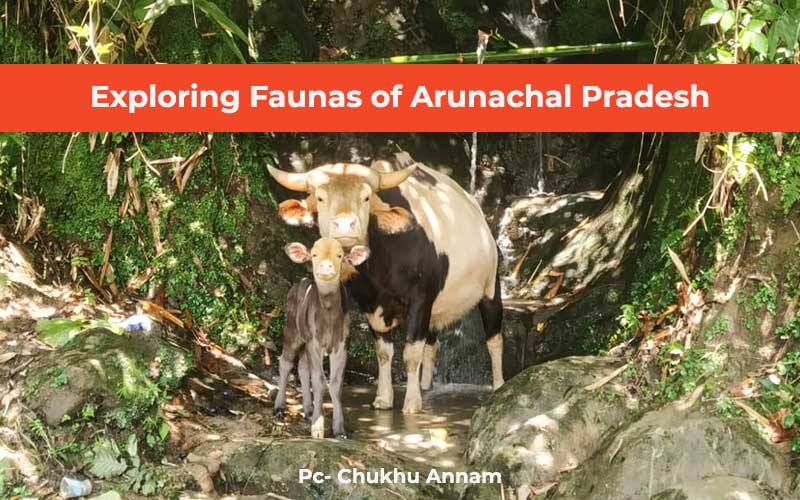
Exploring Faunas of Arunachal Pradesh
The planet Earth is home to many living species and so is important to learn and be aware of the flora and faunas that contribute to balancing the ecosystem. The more we know about their roles in the ecosystem it will become easier for us to understand the importance of protecting these vulnerable species. Arunachal is one such marvel gifted with rich flora and fauna even being home to several endemic and vulnerable species and sub-species. Let's learn about a few of the animals -
Hoolock Gibbon (Hoolockleuconedys)
Hoolock Gibbon is one of the primates that has been classified as Endangered by the International Union for Conservation of Nature (IUCN) Red List, with less than 2000 species. They inhabit mountainous terrains and tropical regions. They can be seen in Itanagar Biological Park, popularly known as the Itanagar Zoo. In 2007, the zoo launched the Hoolock Gibbon Conservation Breeding Programme to protect and conserve the species.
It's still debated whether Hoolock Gibbon or Mithun should be the state animal of Arunachal Pradesh.
Mithun (BosFontalis)
Mithuns are herbivores and prefer habitats at an altitude of 1000m to 3000m in mountainous forests. It is one of the most valuable animals in Arunachal Pradesh. Mithuns embody the distinct socio-cultural significance of the indigenous people of the state. It is valuable in the sense that they play a major part in indigenous culture, rituals, festivals, marriage ceremonies, and consumption. A single adult female Mithun can cost up to Rs 50,000 and more. Accidental harm or damage to this particular animal may cost someone a huge fine or obligation.
Clouded leopard (Neofelisnebulosa)
According to the IUCN Red List, the Clouded leopard has been listed as a vulnerable species. Its population is rapidly declining and on the verge of facing extinction due to illegal poaching and loss of habitat. Although uncertain, experts estimated that less than 10,000 adult Clouded leopards inhabit the wilds in the present day. This nocturnal cat habitat areas in the wilderness of lowland tropical rainforests, dry woodlands, and secondary forests.
Snow Leopard (Pantherauncia)
Snow Leopard, also dubbed as 'The Ghost Cat' is one of the elusive cats classified as vulnerable on the IUCN Red List. Furthermore, the population of Snow Leopards is also increasingly declining due to habitat loss and illegal poaching for its claws, teeth, skin, etc. Its habitat is in the mountainous alpine and subalpine regions at elevations of 3,000m to 4,500m. It is very rare to witness a snow leopard in its natural habitat hence, it is named Ghost Cat because of its timid nature and the ability to camouflage itself.
Recently, Snow Leopard was captured in a lens at the high-altitude area of Arunachal Pradesh but the name of the region where it was observed has not been disclosed for the safety of the animal.
Mishmi Takin (Budorcastaxicolortaxicolor)
Mishmi Takin is the subspecies of Takin (Budorcastaxicolor), a type of goat-antelope. It is classified as endangered species by the International Union for Conservation of Nature (IUCN) and has been listed under Schedule I of the Indian Wildlife (Protection) Act, 1972. They are herbivores that graze leaves, grasses, flowers, bamboo shoots, and willow shoots. Mishmi Takins inhabit the Eastern part of Arunachal Pradesh in mountainous and grass-covered alpine zones, at altitudes between 3,300 and 14,800 ft above sea level. Recently, one Takin was caught by a trap camera above 3,500 metres in the East Kameng district in Arunachal Pradesh. Due to the inaccessibility of their habitat, very little information is available on the species. The type species are conserved at Dibang Wildlife Sanctuary, Anini, Arunachal Pradesh.
Conclusion,
Many species are already extinct and many are on the verge of extinction. It is time we become accountable for our actions and stop encroaching on their habitat and natural vegetation. It is our responsibility to protect the wildlife as in return it will protect our ecosystem. There is a general need of consensus to create awareness of the role and contribution of these animals to our environment.
Disclaimer: The opinions expressed in this article are those of the author's. They do not purport to reflect the opinions or views of The Critical Script or its editor.

Newsletter!!!
Subscribe to our weekly Newsletter and stay tuned.

















Related Comments